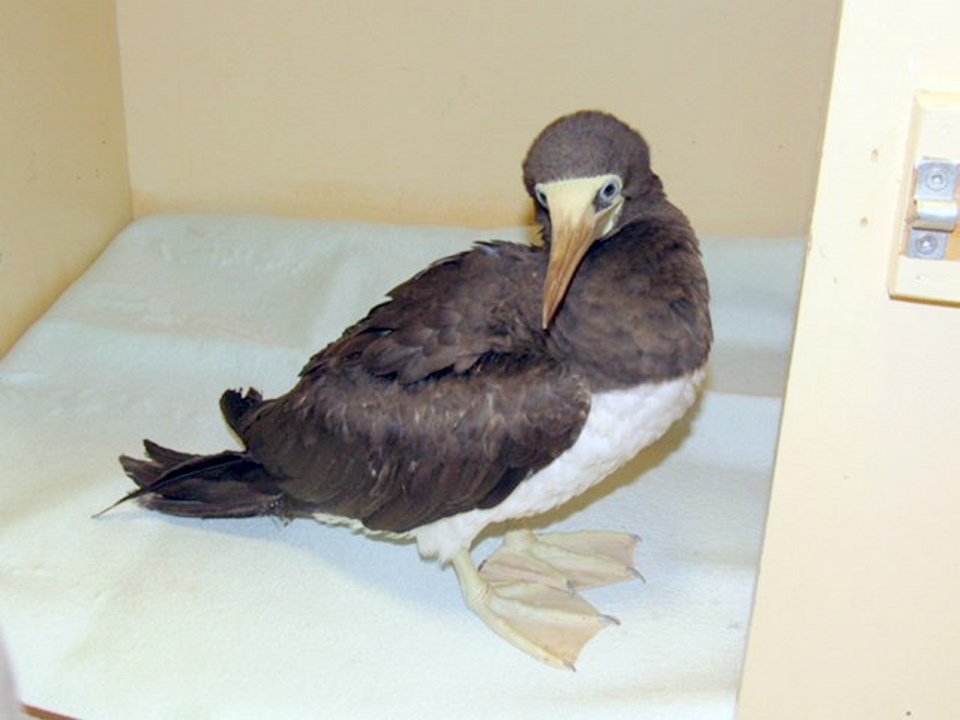June Pigeon had never seen anything like it before.
She works at Ogden Point and about noon on Monday noticed a “weird looking bird” on the pier.
“He was just sort of standing there and he had his head underneath his wings,” she said. “He was just shaking and shivering. You could get right up to him and he’d just look at you, but he wasn’t moving too far.”
It was terrible weather that day, so Pigeon took a couple of pictures and called the B.C. SPCA to ask for advice. She was told to put the bird in a box with holes in it and set the box in a dark place.
The bird put up no resistance. “He was obviously so cold,” Pigeon said.
She set the box in a building where it was warmer and, later that day, one of her colleagues delivered the bird to the SPCA.
Meanwhile, Pigeon posted the bird’s picture on Facebook in hopes that somebody could identify it.
She didn’t wait long.
“I got tons and tons of replies,” she said.
Victoria’s avid birders quickly identified the stranded traveller as a brown booby, a strong-flying, long-winged seabird more commonly found in tropical seas.
Ann Nightingale of the Rocky Point Bird Observatory said it’s rare to see the birds this far north. The first reported sighting was in 2009, she said.
“I’ve only seen one once before and that was in San Diego,” she said. “I’ve spent many hours and quite a few dollars chasing this species in the waters off Victoria.”
Nightingale said she would have headed to Ogden Point at first light Tuesday in hopes of catching a glimpse of the bird if it had been in better shape.
As it was, the booby spent the night at the Central Victoria Veterinary Hospital and was transferred the next morning to the SPCA’s Wild Animal Rehabilitation Centre in Metchosin.
Marguerite Sans, senior wildlife rehabilitator at Wild ARC, said the adult bird was “borderline emaciated” when it arrived with inflamed feet and a small puncture wound on its chest.
The bird was so ill, it was too risky to resume its regular diet of fish and squid. Instead, the centre has been feeding the bird a specialized, easily digestible diet.
Sans said the bird is likely a female although it’s unclear to which of the four subspecies of brown booby she belongs.
“Based on the fact that there’s no white on the head, there’s a little bit of sooty colour in front of the eyes, but no blue, we’re leaning toward female,” she said.
Sans said it’s too soon to say whether the bird will make a full recovery.
“Given how thin she is and the blood results, we’re pretty guarded, because with emaciated patients we can’t tell how well they’ll do until several days later.”
Sans praised Pigeon for doing “everything right” by rescuing the bird. Nightingale said it’s unlikely the bird would have survived a day or two longer in the wild.
“Any time that a bird is able to be caught by humans without a lot of gear it’s not a good sign,” she said.
“So its prognosis without assistance was very poor and its prognosis with assistance is somewhat better. But it will be kudos to the folks at Wild ARC if they’re able to pull it through.”
Wild ARC reports that in the past year alone it helped thousands of injured and orphaned wild animals, including 2,207 birds, 907 mammals, 129 reptiles and three amphibians.



